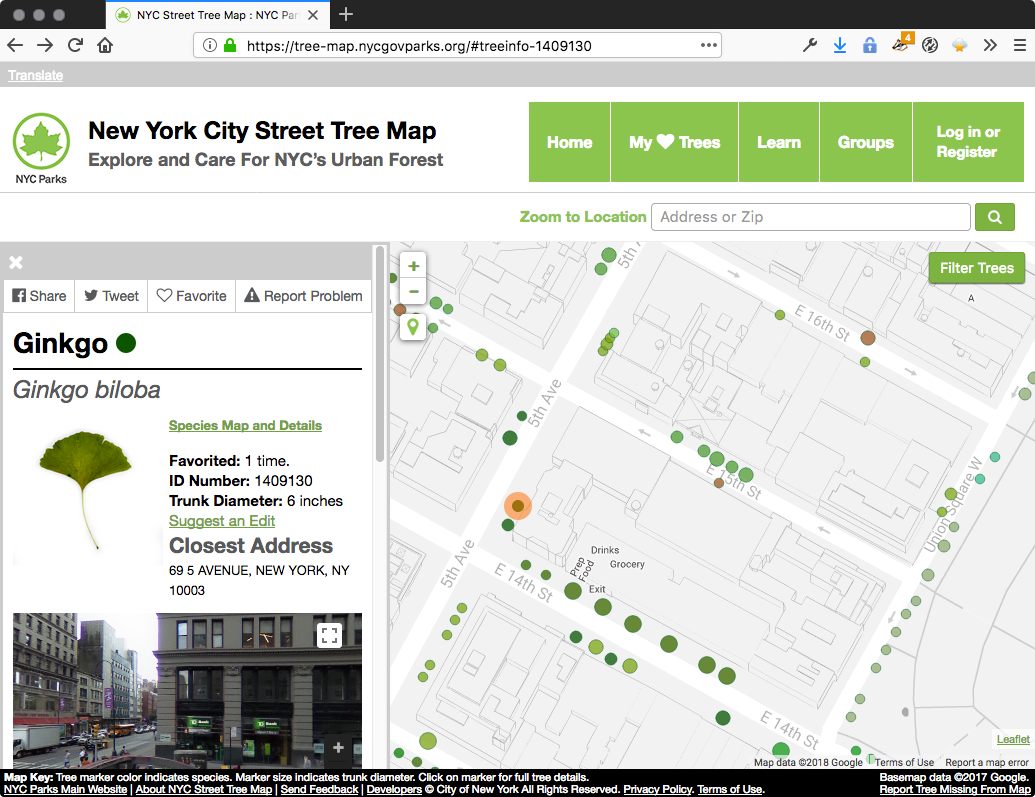SQL & Physical Layout
CSE-4/562 Spring 2019
January 30, 2019
Textbook: Ch. 2.3, 6.1-6.4, and 13.5-13.7
SQL
- Developed by IBM (for System R) in the 1970s.
- Standard used by many vendors.
- SQL-86 (original standard)
- SQL-89 (minor revisions; integrity constraints)
- SQL-92 (major revision; basis for modern SQL)
- SQL-99 (XML, window queries, generated default values)
- SQL 2003 (major revisions to XML support)
- SQL 2008 (minor extensions)
- SQL 2011 (minor extensions; temporal databases)
A Basic SQL Query
SELECT [DISTINCT] targetlist
FROM relationlist
WHERE condition
- Compute the $2^n$ combinations of tuples in all relations appearing in relationlist
- Discard tuples that fail the condition
- Delete attributes not in targetlist
- If DISTINCT is specified, eliminate duplicate rows
This is the least efficient strategy to compute a query! A good optimizer will find more efficient strategies to compute the same answer.
Example Data

SELECT * FROM Trees;Wildcards (*, tablename.*) are special targets that select all attributes.
| CREATED_AT | TREE_ID | BLOCK_ID | THE_GEOM | TREE_DBH | STUMP_DIAM | CURB_LOC | STATUS | HEALTH | SPC_LATIN | SPC_COMMON | STEWARD | GUARDS | SIDEWALK | USER_TYPE | PROBLEMS | ROOT_STONE | ROOT_GRATE | ROOT_OTHER | TRNK_WIRE | TRNK_LIGHT | TRNK_OTHER | BRNCH_LIGH | BRNCH_SHOE | BRNCH_OTHE | ADDRESS | ZIPCODE | ZIP_CITY | CB_NUM | BOROCODE | BORONAME | CNCLDIST | ST_ASSEM | ST_SENATE | NTA | NTA_NAME | BORO_CT | STATE | LATITUDE | LONGITUDE | X_SP | Y_SP |
|---|---|---|---|---|---|---|---|---|---|---|---|---|---|---|---|---|---|---|---|---|---|---|---|---|---|---|---|---|---|---|---|---|---|---|---|---|---|---|---|---|---|
| '08/27/2015' | 180683 | 348711 | 'POINT (-73.84421521958048 40.723091773924274)' | 3 | 0 | 'OnCurb' | 'Alive' | 'Fair' | 'Acer rubrum' | 'red maple' | 'None' | 'None' | 'NoDamage' | 'TreesCount Staff' | 'None' | 'No' | 'No' | 'No' | 'No' | 'No' | 'No' | 'No' | 'No' | 'No' | '108-005 70 AVENUE' | '11375' | 'Forest Hills' | 406 | 4 | 'Queens' | 29 | 28 | 16 | 'QN17' | 'Forest Hills' | 4073900 | 'New York' | 40.72309177 | -73.84421522 | 1027431.14821 | 202756.768749 |
| '09/03/2015' | 200540 | 315986 | 'POINT (-73.81867945834878 40.79411066708779)' | 21 | 0 | 'OnCurb' | 'Alive' | 'Fair' | 'Quercus palustris' | 'pin oak' | 'None' | 'None' | 'Damage' | 'TreesCount Staff' | 'Stones' | 'Yes' | 'No' | 'No' | 'No' | 'No' | 'No' | 'No' | 'No' | 'No' | '147-074 7 AVENUE' | '11357' | 'Whitestone' | 407 | 4 | 'Queens' | 19 | 27 | 11 | 'QN49' | 'Whitestone' | 4097300 | 'New York' | 40.79411067 | -73.81867946 | 1034455.70109 | 228644.837379 |
| '09/05/2015' | 204026 | 218365 | 'POINT (-73.93660770459083 40.717580740099116)' | 3 | 0 | 'OnCurb' | 'Alive' | 'Good' | 'Gleditsia triacanthos var. inermis' | 'honeylocust' | '1or2' | 'None' | 'Damage' | 'Volunteer' | 'None' | 'No' | 'No' | 'No' | 'No' | 'No' | 'No' | 'No' | 'No' | 'No' | '390 MORGAN AVENUE' | '11211' | 'Brooklyn' | 301 | 3 | 'Brooklyn' | 34 | 50 | 18 | 'BK90' | 'East Williamsburg' | 3044900 | 'New York' | 40.71758074 | -73.9366077 | 1001822.83131 | 200716.891267 |
| '09/05/2015' | 204337 | 217969 | 'POINT (-73.93445615919741 40.713537494833226)' | 10 | 0 | 'OnCurb' | 'Alive' | 'Good' | 'Gleditsia triacanthos var. inermis' | 'honeylocust' | 'None' | 'None' | 'Damage' | 'Volunteer' | 'Stones' | 'Yes' | 'No' | 'No' | 'No' | 'No' | 'No' | 'No' | 'No' | 'No' | '1027 GRAND STREET' | '11211' | 'Brooklyn' | 301 | 3 | 'Brooklyn' | 34 | 53 | 18 | 'BK90' | 'East Williamsburg' | 3044900 | 'New York' | 40.71353749 | -73.93445616 | 1002420.35833 | 199244.253136 |
| '08/30/2015' | 189565 | 223043 | 'POINT (-73.97597938483258 40.66677775537875)' | 21 | 0 | 'OnCurb' | 'Alive' | 'Good' | 'Tilia americana' | 'American linden' | 'None' | 'None' | 'Damage' | 'Volunteer' | 'Stones' | 'Yes' | 'No' | 'No' | 'No' | 'No' | 'No' | 'No' | 'No' | 'No' | '603 6 STREET' | '11215' | 'Brooklyn' | 306 | 3 | 'Brooklyn' | 39 | 44 | 21 | 'BK37' | 'Park Slope-Gowanus' | 3016500 | 'New York' | 40.66677776 | -73.97597938 | 990913.775046 | 182202.425999 |
| ... and 683783 more | |||||||||||||||||||||||||||||||||||||||||
SELECT tree_id, spc_common, boroname
FROM Trees
WHERE boroname = 'Brooklyn'
In English, what does this query compute?
What is the ID, Commmon Name and Borough of Trees in Brooklyn?
| TREE_ID | SPC_COMMON | BORONAME |
|---|---|---|
| 204026 | 'honeylocust' | 'Brooklyn' |
| 204337 | 'honeylocust' | 'Brooklyn' |
| 189565 | 'American linden' | 'Brooklyn' |
| 192755 | 'London planetree' | 'Brooklyn' |
| 189465 | 'London planetree' | 'Brooklyn' |
| ... and 177287 more | ||
SELECT latitude, longitude
FROM Trees, SpeciesInfo
WHERE Trees.spc_common = SpeciesInfo.name
AND SpeciesInfo.has_unpleasant_smell = 'Yes';
In English, what does this query compute?
What are the coordinates of Trees with bad smells?
| LATITUDE | LONGITUDE | |||
|---|---|---|---|---|
| 40.59378755 | -73.9915968 | |||
| 40.69149917 | -73.97258754 | |||
| 40.74829709 | -73.98065645 | |||
| 40.68767857 | -73.96764605 | |||
| 40.739991 | -73.86526993 | |||
| ... and more | ||||
SELECT Trees.latitude, Trees.longitude
FROM Trees, SpeciesInfo
WHERE Trees.spc_common = SpeciesInfo.name
AND SpeciesInfo.has_unpleasant_smell = 'Yes';
... is the same as ...
SELECT T.latitude, T.longitude
FROM Trees T, SpeciesInfo S
WHERE T.spc_common = S.name
AND S.has_unpleasant_smell = 'Yes';
... is (usually) the same as ...
SELECT latitude, longitude
FROM Trees, SpeciesInfo
WHERE spc_common = name
AND has_unpleasant_smell = 'Yes';
Expressions
SELECT tree_id,
stump_diam / 2 AS stump_radius,
stump_area = 3.14 * stump_diam * stump_diam / 4
FROM Trees;
Arithmetic expressions can appear in targets or conditions. Use ‘=’ or ‘AS’ to assign names to these attributes. (The behavior of unnamed attributes is unspecified)
Expressions
SELECT tree_id, spc_common FROM Trees WHERE spc_common LIKE '%maple'
| TREE_ID | SPC_COMMON |
|---|---|
| 180683 | 'red maple' |
| 204325 | 'sycamore maple' |
| 205044 | 'Amur maple' |
| 184031 | 'red maple' |
| 208974 | 'red maple' |
SQL uses single quotes for ‘string literals’
LIKE is used for String Matches
‘%’ matches 0 or more characters
Union
SELECT tree_id FROM Trees WHERE spc_common = 'red maple'
UNION [ALL]
SELECT tree_id FROM Trees WHERE spc_common = 'sycamore maple'
Computes the set-union of any two union-compatible sets of tuples
Adding ALL preserves duplicates across the inputs (bag-union).
Aggregate Queries
SELECT [DISTINCT] targetlist
FROM relationlist
WHERE condition
GROUP BY groupinglist
HAVING groupcondition
The targetlist now contains (a) Grouped attributes, and (b)Aggregate expressions.
Targets of type (a) must be a subset of the grouping-list
(intuitively each answer tuple corresponds to a single group, and each group must have a single value for each attribute)
groupcondition is applied after aggregation and may contain aggregate expressions.
Aggregate Queries
SELECT spc_common, count(*) FROM Trees GROUP BY spc_common
| SPC_COMMON | COUNT |
|---|---|
| ''Schubert' chokecherry' | 4888 |
| 'American beech' | 273 |
| 'American elm' | 7975 |
| 'American hophornbeam' | 1081 |
| 'American hornbeam' | 1517 |
| ... and more | |
Physical Layout
from re import split;
with open('Trees.csv', 'r') as f:
for line in f:
fields = split(",", line);
if(fields[30] == 'Brooklyn'):
print(fields[0]);
Record Layouts
Record Layout 1: Fixed
Record Layout 2: Delimiters
Record Layout 2: Headers
Record Formats
- Fixed
- Constant-size fields. Field $i$ at byte $\sum_{j < i} |Field_j|$
- Delimited
- Special character or string (e.g.,
,) between fields - Header
- Fixed-size header points to start of each field
File Formats
- Fixed
- Constant-size records. Record $i$ at byte $|Record| \times i$
- Delimited
- Special character or string (e.g.,
\r\n) at record end - Header
- Index in file points to start of each record
- Paged
- Align records to paging boundaries

- File
- A collection of pages (or records)
- Page
- A fixed-size collection of records
- Page size is usually dictated by hardware.
Mem Page $\approx$ 4KB Cache Line $\approx$ 64B - Record
- One or more fields (for now)
- Field
- A primitive value (for now)
with db_open('Trees') as data:
for record in data:
if(record['BORONAME'] == 'Brooklyn'):
print(record['TREE_ID']);